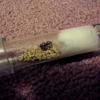A few days ago, when out checking to see if T. immigrans would be flying, I decided to flip up a few stones and see what ants I'd find. I occasionally do this to check on colonies to see when they'll have alates so I can watch for flights.
I found a massive Solenopsis molesta colony that was stealing brood from multiple species of ants. I managed to collect maybe 1/4 of the colony at most, and 4 of their queens. I caught 70 queens of this species 2 years ago and they've been on my bucket list ever since, so needless to say, I was ecstatic.
The colony I collected has at least 500 workers, probably more in the ballpark of 1,000. They've got too much brood to count ![]() .
.
Please excuse some of the poor camera work. These ants are absolutely tiny, with workers about 1mm in length.




As you can see, they also have some alate brood on the way. Probably 50-100 pieces. Like with my other current colonies, if they manage to get female and male alates, I will attempt to breed them. I don't know how succesful I will be, but I'll try nonetheless ![]()






















